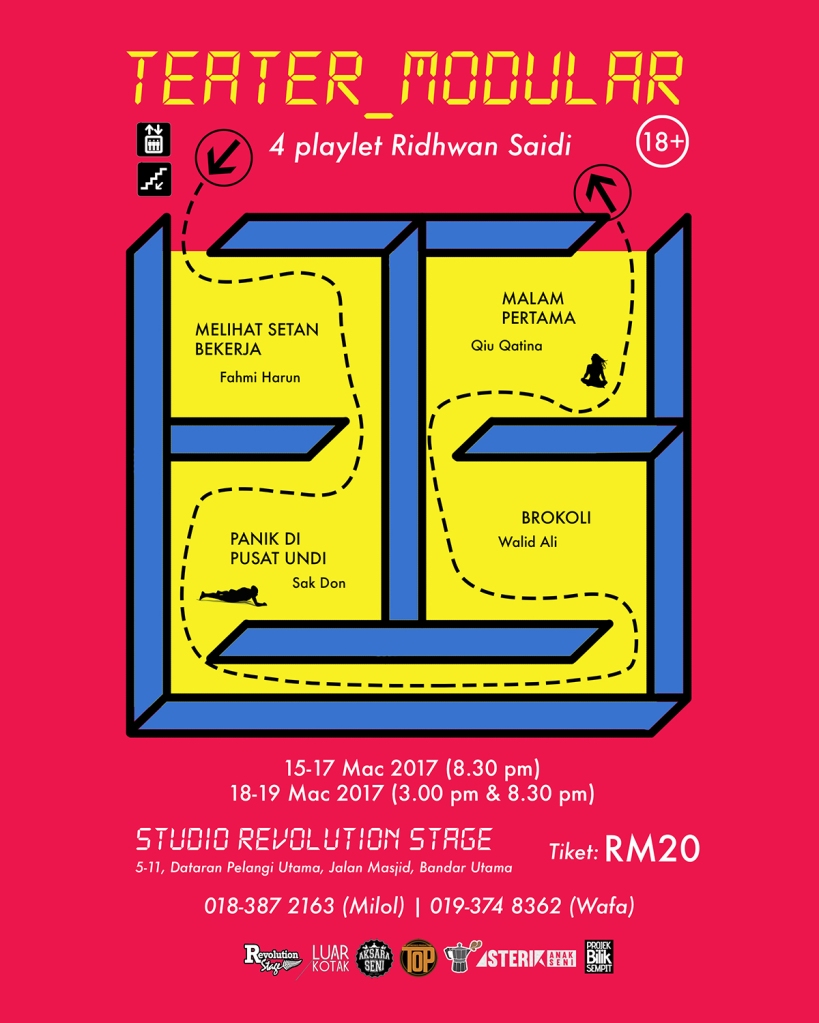NARATIF TEATER MODULAR
I want to explore new territories in literature through playwriting (after dabbling with novels, short stories, essays, and poetry). But what makes playwriting special is that the text-based written element is only half of it. The other half is the manifestation of the text itself, when it is transformed into space with actors, etc. Thus, my intention is to create new works that can be enjoyed by reading the text (as literature) and experiencing it when it turns into a performance (as theatre). Therefore, Teater Modular consists of two forms: a book and past/future performances.
In a way, it’s also a supplement to Malaysia’s stage play corpus. Playwriting is the least preferred reading form for readers (and writers too); therefore, with playlets (short plays), I can display how good old storytelling works, and I hope people (readers or audience) can enjoy it as much as I do.
Theatre is poetry in space; hence, for all three series, I try to provide three different space qualities for the directors. For our first series, it was staged in a small blackbox in a shoplot (Revolution Stage, Bandar Utama). It was chosen out of necessity. We needed a space that has been catering to regular theatre-going audiences, and for us, that is important because we are new.
For the second series, I think we are more confident, and we had it at a basement turned makerspace (Makespace, Quill City Mall), which is still within the city centre of Kuala Lumpur (opposite Sheraton and Jalan Doraisamy, and near LRT station). This time the space is more open and much bigger (6,000 square feet of performance/audience area, not including the storage area) compared to our first theatre-making experience at Revolution Stage (around 400 square feet of performance/audience area). This time during the site visit, I let the directors choose their own spot and tried to articulate what the best flow was for the audience to move from one playlet to the next.
In this second series, we also started using English subtitles provided by Alfian Sa’at (he translated all 13 playlets!), so this time there’s a need for new equipment in the production, which is a projector. We have 4 playlets, but we managed to get 3 projectors—two playlets had to share one projector. These are some of the constraints I need to think of when ‘curating’ the flow. Apart from that, we have limited chairs, so the audience needs to drag chairs from one playlet to the other (in the dark, towards the light).
This second series is special in the sense that it has three female directors and one male (Mia, Nana, Qiu, and Walid). I purposely did this to counter our first show, which consists of three male and one female directors. For the third series, my initial intention was to make it even with two male and two female directors, but unfortunately, one of the female directors couldn’t commit. Hence, the reason why I took the spot as director was to avoid further last-minute problems.
For the third series, we have two options. Either we go back to a more conventional blackbox theatre space with regular audience flow or go to some unlikely theatre spaces like KongsiKL. It’s a huge (10,000 square feet!) double-volume space that we haven’t experienced before. I came to the launch of this space in December 2017, and I know I want to do Teater Modular here. At the launch event, there were no chairs, and supposedly, when I rent KongsiKL, chairs will not be provided. It’s only when we bumped for set-up that we realised there were some chairs in the gudang.
In terms of set design, I believe in sustainability. We just used whatever was available at KongsiKL. For example, there’s a steel door on one side of the space, and there’s also scaffolding. I provided Sesuap Kaseh with these two elements because they suit the story. You need some fresh air for Sesuap Kaseh (it’s the only playlet with an outdoor setting), and the scaffolding can be the waterfall. In the meantime, KongsiKL is in the middle of renovating its indoor toilet, and there were bricks and other building materials. So we are practically borrowing the bricks for our set design and making up the pedestal to put our projectors (for subtitles).
Speaking of projectors, this time around we only have two projectors. Therefore, two playlets are to share one projector (the third projector we use in Makespace is actually a projector we found inside the storage area). The flow is tighter because, as one playlet is happening, we need to move and set up the other projector and laptop in a new position.
In this third series, we try to do a morning show. It’s not because we want to do it for the sake of doing it; again, it’s out of necessity. We know the gudang will be very hot during the normal 3 p.m. matinee show. So we decided to do it at 10 a.m. And instead of doing it on both Saturday and Sunday, we did it only on Saturday, just to test it—to see if there would be an audience.
For the third series, we play around with the sequence of the playlets. It provided different narratives and feelings. For example, when we end it with Erti Mati, there were a lot of questions and critical thinking happening during the bual santai session, but when we end it with Sesuap Kaseh, people are more laidback and just have smiles on their faces. This, of course, depends on the crowd, but somehow it is the impression that I got.
We have been doing post-performance discussion sessions (we call them sesi bual santai) for each Teater Modular performance in all three series, as well as the Bengkel Modular showcase and the Singapore reading showcase. What I’ve written above is basically the three main Teater Modular series, which consist of four playlets each, making it 12 in total. But there are 13 playlets overall for Teater Modular. The extra playlet is from Bengkel Modular, which I did in September 2017 (this is a month before the second series and 6 months after the first one).
For Bengkel Modular, I conducted a devised workshop for Playlet 13 for two weeks at a makeshift blackbox in Quill City Mall as part of the event called #rasasayang. There were three makeshift black boxes with different stagings and events throughout the month. The playlet 13 is basically about semangat kejiranan between heaven and hell. In playlet 13, the idea is that there’s a blackout in heaven, so the heaven-dweller needs to go to hell to borrow some light (api). At the same time, there was no water in hell, so the hell-dweller needed to take some water from the rivers (madu, susu, and arak) in heaven. I was to devise the play based on the number of participants. Three people joined the two-week workshop. So then we developed the idea and turned it into a playlet (for which I eventually wrote the script). Finally, we showcased it for two days at the end of the workshop.
A day after finishing the 2-week workshop, with a prior invitation from Alfian Sa’at, I went to Singapore for 5 days to do a reading showcase of Teater Modular (5 playlets were chosen, and I directed the actors). Instead of just sitting and reading, it’s in the form of dramatised reading. Basically, it’s a theatre performance, but with a script in hand. We did a rehearsal one day earlier. During this time, Alfian Sa’at prepared English subtitles for the Singaporean audience (that we will be using in Malaysia for our upcoming shows).
The next day, Teater Ekamatra provided me with a space to do a playwriting workshop with nearly 20 participants. I haven’t done any writing or playwriting workshops in Malaysia, but currently I’m running a bi-weekly reading group (Sesi Diskusi Buku KAOS NOL) in PJ, focusing on theatre and aesthetics. Tentatively, five sessions are scheduled, and we plan to produce a performance out of them under my newly established group, Ensembel Teater KAOS NOL.
I don’t separate the final output from the process because the act of making it itself is part of the point. Teater Modular is a slow-burn, long-term project. When I first initiated it, I imagined doing one series per year. So supposedly, three series were to take three years to be staged, and the book would come after that, in the fourth or fifth year. But it seems that we are progressing much faster than I imagined—we did all three series in one year. This urgency… maybe it’s out of necessity too.
Currently, Moka Mocha Ink is editing and designing the Teater Modular Box Set, a set of 13 playscripts in Malay and English that can be arranged and rearranged so that readers and/or future directors and producers can play around with the sequences of the playlets.
Ridhwan Saidi // 2018






